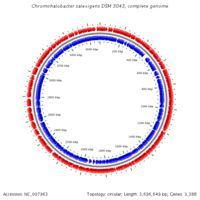Chromohalobacter Salexigens: Difference between revisions
m (→Ecology) |
|||
| Line 45: | Line 45: | ||
==Ecology== | ==Ecology== | ||
Describe any interactions with other organisms (included eukaryotes), contributions to the environment, effect on environment, etc. | Describe any interactions with other organisms (included eukaryotes), contributions to the environment, effect on environment, etc. | ||
N(gamma)-acetyl-2,4-diaminobutyrate (NADA), the precursor of the compatible solute ectoine, was shown to function as an osmoprotectant for the non-halophilic bacterium Salmonella enterica serovar Typhimurium. The addition of NADA-containing extracts of an ectoine synthase mutant of the broad salt-growing halophile Chromohalobacter salexigens DSM 3043(T) could alleviate the inhibitory effects of high salinity in S. enterica, which lacks the ectoine biosynthetic pathway. NADA, purified from extracts of the mutant, protected S. enterica against salinity stress. | |||
==Pathology== | ==Pathology== | ||
Revision as of 19:04, 2 May 2007
A Microbial Biorealm page on the genus Chromohalobacter Salexigens
Classification
Higher order taxa
Bacteria; Proteobacteria; Gammaproteobacteria; Oceanospirillales; Halomonadaceae; Chromohalobacter;
Species
C. Salexigens
Description and significance
Describe the appearance, habitat, etc. of the organism, and why it is important enough to have its genome sequenced. Describe how and where it was isolated. Include a picture or two (with sources) if you can find them.

This bacterium is a moderate halophile, yet does not require high concentrations of sodium chloride. The salt requirements of this organism can be met by ions of other salts, such as potassium, rubidium, ammonium, bromide, and others.
Genome structure
Describe the size and content of the genome. How many chromosomes? Circular or linear? Other interesting features? What is known about its sequence? Does it have any plasmids? Are they important to the organism's lifestyle?
DNA Bases: 3696649
Chromosome Type: Circular
Total Genes: 3403
Protein Coding Genes: 3319 RNA Genes: 84 Pseudo Genes: 21
Cell structure and metabolism
Describe any interesting features and/or cell structures; how it gains energy; what important molecules it produces.
The growth rate of Chromohalobacter salexigens DSM 3043 can be stimulated in media containing 0.3 M NaCl by a 0.7 M concentration of other salts of Na+, K+, Rb+, or NH4+, Cl-, Br-, NO3-, or SO4(2-) ions.
Ecology
Describe any interactions with other organisms (included eukaryotes), contributions to the environment, effect on environment, etc.
N(gamma)-acetyl-2,4-diaminobutyrate (NADA), the precursor of the compatible solute ectoine, was shown to function as an osmoprotectant for the non-halophilic bacterium Salmonella enterica serovar Typhimurium. The addition of NADA-containing extracts of an ectoine synthase mutant of the broad salt-growing halophile Chromohalobacter salexigens DSM 3043(T) could alleviate the inhibitory effects of high salinity in S. enterica, which lacks the ectoine biosynthetic pathway. NADA, purified from extracts of the mutant, protected S. enterica against salinity stress.
Pathology
C. Salexigens is not known to be pathogenic
Application to Biotechnology
Does this organism produce any useful compounds or enzymes? What are they and how are they used?
The halophilic bacterium Chromohalobacter salexigens synthesizes and accumulates compatible solutes in response to salt and temperature stress. The ectD gene, which is involved in the synthesis of the compatible solute hydroxyectoine, is essential for thermoprotection of the halophilic bacterium Chromohalobacter salexigens.
Current Research
Enter summaries of the most recent research here--at least three required
References
Edited by Chris Wittrock, a student of Rachel Larsen and Kit Pogliano
